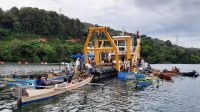Poso City,- BOUNDARIES On written references seem to be a challenge in tracking the origins of To Pamona. It is recognized by several resources in Poso. The only written reference that outlines To Pamona so far, much sourced from the record of Albert Cristian Kruyt, who was first known to have set foot on the Poso tana in 1892.
He is Luther Mansyur Andi Baso Meringgi, S.Th, one of the ethno-rhythm observers, tried to decipher the To Pamona’s origins by linking it with Luwu Unity. The author of ‘Growing and Fruiting For All’ begins by ensuring that, “the story of Lasaeo is not a myth”. On the other hand, Lasaeo is a magic figure from Luwu who married Rumongi, the adopted son of the Rumbenunu and Roe Mbetue married couples who previously existed in the Pamona village (now called Pamona Urban Village).
The same thing was put forward by Gustaf Tadjongga. According to the former Lurah Lombugia, Rumbenunu and Roe Mbetue’s marriage had no children, so Rumongi was adopted as his adopted son, later Rumongi was married by Lasaeo. From here Gustaf said, began to develop Pamona people (To Pamona), after which they split from Pamona Hill marked by Watu Mpogaa (farewell stone).
Gustaf’s statement in tune with Baso Meringgi. According to these two sources, from Rumbenunu, Lasaeo with his wife Rumongi, indeed we can start the origin of To Pamona. After that, we may try to associate with the presence of Watu Mpogaa in Pamona Village today. Baso Meringgi added that Lasaeo is the fifth generation of the Sawerigading Kingdom which reigns in Tana Luwu (Now Luwu County). He came to Tana Poso (Pamona) around 1117, to widen his wings, when Pamona’s earth was still inhabited by a group of still-moving people. “So once again, Lasaeo is not a myth, it exists and is recorded in the history of Luwu Kingdom, Southern Sulawesi”, said Luther Meringgi.
That’s how Luther Raised and Gustaf Tadjongga tried to unravel To Pamona’s footsteps, by describing the Pamona’s association with Luwu. “Pamona cannot be separated with Luwu, the evidence to date, the Pamona tribe is listed as a child of the 12th tribe in the Luwu Kingdom genealogy”, said Baso Meringgi, as he flicked through his handbook.
Today, the Pamona tribe sounds faintly, drowned by the name of Poso inherent as the name of a Regency, so to distinguish Poso as a territory and Pamona as a native inhabitant, sometimes confused by improper language usage. “So in my opinion, there is no Poso Tribe, because Poso is just a region name. The original tribe of Tana Poso is To Pamona, which is divided into several sub ethnic, among others, Ondae, Lamusa, Wingke Ndano, Lage, and Pebato, and Tojo, “explained Luther Meringgi.
A number of written references found by the authors mention the spreading of Pamona (sub ethnic) tribal children, post the presence of Lasaeo in Pamona, starting from the hill of Pamona, which is marked by historical evidence in the form of stone known as ‘Watu Mpogaa’ (stone / monument). The farewell trail in the ranks of the stone is still well preserved, in the Bethel-Pamona-Tentena Church area, Pamona Puselemba District.
Baso Meringgi predicts, the presence of La Saeo in Pamona (Tentena) has passed 900 years ago. That is, the traces of To Pamona can be traced by trying to unravel it carefully from Year 1117. “So To Pamona traces started from Year 1117 because in the history of the Kingdom of Luwu is told, Lasaeo came to Pamona, when the figure is described as a large, white, and handsome face, is holding the reins of the 5th Luwu Kingdom (Wotu). And it is told that Lasaeo did not continue his throne, having to wander to Pamona “, explained Luther Mansyur Andi Baso Meringgi, in a conversation with Kaili Post one day, at his residence. **
Reporter/editor: Darwis waru








